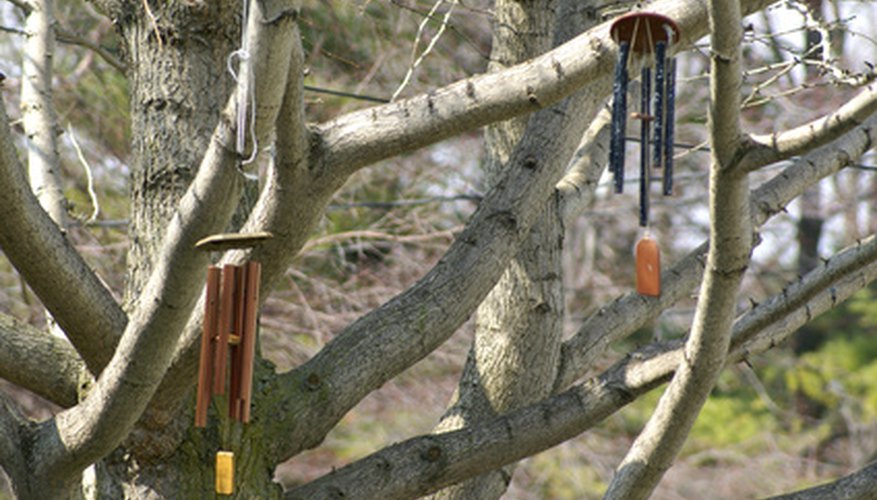Wind chimes add a musical dimension to outdoor life. From tuned brass to homemade shell, beach glass and other rustic styles, chimes add a decorative and pleasant sounding feature to your yard. Over time, weather takes a toll on wind chimes and those strung with string require restringing. If parts are damaged, replace them with similar parts from used wind chimes. Follow a basic strategy for restringing wind chimes and caring for them to prolong their lives.
- Wind chimes add a musical dimension to outdoor life.
- Over time, weather takes a toll on wind chimes and those strung with string require restringing.
Set the wind chimes on a table. Leave all the parts intact and examine them. Usually, there's a central clapper the other strands of the wind chime hit. In some wind chime styles, such as those made of seashells, the strands simply hit against each other to produce sound. If the wind chimes are made of metal tubes, measure the strands from where they attach to the top of the tubes. Measure the clapper strand from the top to the top of the clapper. For other types, measure the distance from the top of the strand to the position of the first ornament.
Wipe the wind chime parts clean with a damp rag. Use mild soap on glass, shells or other hard materials. Wipe wooden parts with lemon oil.
Cut one strand of the wind chime. Remove it from the top and cut it off of each part on the strand. It works well to restring one strand at a time, so that if you aren't certain of how it goes, you can check an intact strand.
Cut a length of fishing line the same length as the wind chime strand you cut, plus two inches for knots.
- Wipe the wind chime parts clean with a damp rag.
- Cut a length of fishing line the same length as the wind chime strand you cut, plus two inches for knots.
Restring each part on the strand. Hold the fishing line securely between two fingers and poke the end through the hole in the wind chime part. Secure each part in position with a knot. Use a needle nose pliers or tweezers to help make knots in the fishing line to if it's difficult for you to do with your fingers. A square knot or any kind of knot works fine.
- Restring each part on the strand.
- Secure each part in position with a knot.
Repeat Steps 3 through 5 for each wind chime strand, finishing with the clapper strand.
Re-hang the wind chimes.
TIP
If you have more than one set of wind chimes to restring, restring one at a time to avoid getting parts or measurements mixed up. Weathering of metal chimes is normal. Attempts to polish brass or other metals tends to yield unsatisfactory results--unevenness in the finish becomes more visible. Some wind chimes manufacturers offer replacement parts. Contact the retailer where you bought the wind chimes for assistance if you don't have information on the manufacturer. Metal wind chimes are often tuned, so it's important to restring the parts in the correct positions.
